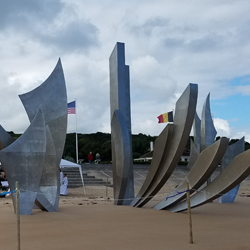


Hype:
Omaha Beach was the code name for one of the five sectors of the Allied invasion of German-occupied France in the Normandy landings on 6 June 1944, during World War II. Omaha refers to a section of the coast of Normandy, France, facing the English Channel 5 mi long. Landings here were necessary to link the British landings to the east at Gold with the American landing to the west at Utah, thus providing a continuous lodgement on the Normandy coast of the Bay of the Seine. Taking Omaha was to be the responsibility of United States Army troops, with sea transport, mine sweeping, and a naval bombardment force provided predominantly by the United States Navy and Coast Guard, with contributions from the British, Canadian, and Free French navies. On D-Day, the untested 29th Infantry Division, along with nine companies of U.S. Army Rangers redirected from Pointe du Hoc, were to assault the western half of the beach. The battle-hardened 1st Infantry Division was given the eastern half. The initial assault waves, consisting of tanks, infantry, and combat engineer forces, were carefully planned to reduce the coastal defenses and allow the larger ships of the follow-up waves to land. The primary objective at Omaha was to secure a beachhead of 5 miles depth. Very little went as planned during the landing at Omaha. Difficulties in navigation caused the majority of landing craft to miss their targets throughout the day. The defenses were unexpectedly strong, and inflicted heavy casualties on landing U.S. troops. Under heavy fire, the engineers struggled to clear the beach obstacles; later landings bunched up around the few channels that were cleared. Weakened by the casualties taken just in landing, the surviving assault troops could not clear the heavily defended exits off the beach. This caused further problems and consequent delays for later landings. Small penetrations were eventually achieved by groups of survivors making improvised assaults, scaling the bluffs between the most heavily defended points. By the end of the day, two small isolated footholds had been won, which were subsequently exploited against weaker defenses further inland, thus achieving the original D-Day objectives over the following days.
Time:
Fees: None
Recommended Ages:
 | 0-3 |
 | 4-11 |
 | 12-19 |
 | 20-49 |
 | 50-69 |
 | 70+ |
Recommended Months to Visit:
| Jan |
| Feb |
| Mar |
| Apr |
| May |
| Jun |
| Jul |
| Aug |
| Sep |
| Oct |
| Nov |
| Dec |
Links: https://en.wikipedia.org/
Navigate to 49.369681, -0.871084.
By Jeremy Dye
Jeremy Dye, Tara Dye, Greg Dye, Laura Dye,
This was a fun monument to visit. We had just enough time to walk out to the water and back to the bus.
 Cathedrale Notre-Dame de Paris
Cathedrale Notre-Dame de Paris
 Musee de Cluny - Musee National du Moyen Age
Musee de Cluny - Musee National du Moyen Age
 La Basilique du Sacre Coeur de Montmartre
La Basilique du Sacre Coeur de Montmartre
 La Maison de la Magie Robert-Houdin
La Maison de la Magie Robert-Houdin
 Royal Abbey of Our Lady of Fontevraud
Royal Abbey of Our Lady of Fontevraud
 Basilica of St. Nicholas of Nantes
Basilica of St. Nicholas of Nantes
 Normandy American Cemetery and Memorial
Normandy American Cemetery and Memorial
 Cathedrale Notre-Dame de Bayeux
Cathedrale Notre-Dame de Bayeux
 Musee de la Tapisserie de Bayeux
Musee de la Tapisserie de Bayeux